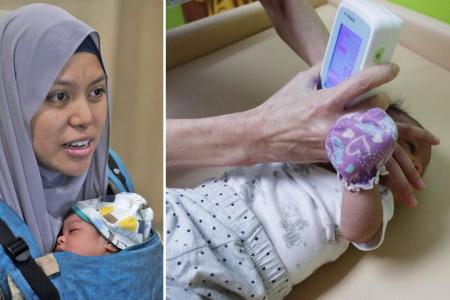New test for jaundice eases the pain for newborns
When Madam Nursurya Zaini took her infant son to be screened for jaundice two years ago, she saw laboratory technicians draw blood from his heel. The baby bawled, which pained the mother as well.
But with her newborn daughter - three-week-old Erina Irwan - the process was painless because of a new screening tool at the National University Polyclinics (NUP).
Known as a transcutaneous bilirubin measurement, the new technique relies on flashes of light to calculate a baby's bilirubin level.
CHEAPER
It is cheaper than the traditional heel prick test, equally accurate and delivers results in a fraction of the time. This is the first time that this test is being used in a polyclinic setting.
Bilirubin is a yellow pigment found in babies with jaundice. High levels of bilirubin can cause brain damage or seizures.
"The heel prick test is quite distressing for the parents, and for the child, it is painful," said Dr Ruth Zheng, a family physician at NUP. "That got us thinking if there is a better way."
The new method involves placing a measurement device on to the baby's chest until a flash of light is seen.
Five measurements are taken and the results are available in two minutes.
In comparison, parents would have to wait around half an hour for results from the heel prick test.
The test was rolled out at all six NUP polyclinics in May. Now, the clinics screen around 600 babies aged two weeks and under for jaundice every month.
Only two in 10 babies - typically those with higher levels of bilirubin in their blood - will require an additional heel prick test.
Dr Chinnadurai Amutha, a senior consultant at the National University Hospital's neonatology department, said that 60 to 80 per cent of babies are born with signs of jaundice.
However, these signs generally fade after two weeks.
Get The New Paper on your phone with the free TNP app. Download from the Apple App Store or Google Play Store now



